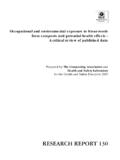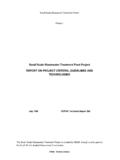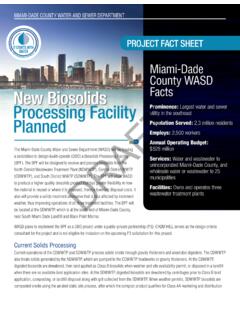Transcription of Manure Storage for Horse Facilities
1 1If water, typically rainfall, drains through the pile and the material becomes saturated, the nutrients in the Manure can leach or seep out of the Manure pile and then percolate down into the ground. Leachate is the dark brown liq-uid, sometimes called Manure tea, that can sometimes be seen pooled around Manure piles in wet weather. In floodplains and areas adjacent to streams, the water table may be high. Storing Manure in an area with a high water table could potentially con-taminate groundwater. Manure should be stored away from any stream or well used as a source of drinking water. The Water Qual-ity Monitoring fact sheet in thisRainfall and storm water runoff that comes into con-tact with Manure , if not properly managed and treated, can carry nutrients, pathogens, salts and other constituents to nearby streams, negatively impacting water quality and aquatic life. As a general rule, Manure Storage sites should be located 50-100 feet, depending on site conditions, from any stream or drainage course, and likewise away from water wells.
2 County or city agen-cies may have required setback distances which can be greater than those which may be required by state agencies. Local depart-ments of public health or plan-ning may be a good first place to start for local information about protecting water quality in water wells and creeks. Manure stored in or adjacent to a watercourse can result in the imposition of fines and penalties from regula-tory agencies. Manure Storage Facilities should also be located outside of floodplains. However, if site restrictions necessitate loca-tion within a floodplain, the stor-age area should be protected from inundation or damage from a storm or flood event. A 1,000 pound Horse can generate cubic feet of Manure each day. (See References Cited). Equestrians need to provide proper handling and Storage of Manure , along with a plan for effective Manure utilization, in order to avoid potential environmental/regulatory problems.
3 Manure Storage is a temporary containment of equine waste and provides the Horse owner or manager with flexibility in scheduling the final utilization, recycling or disposal of the waste. Manure Storage practices should be used in combination with other Horse keeping management practices contained in a facility s conservation plan for maximum protection of water quality. Manure Storage for Horse Facilities Why is Proper Storage Necessary?Fact SheetEquine Facilities Manure Management PracticesJune 2003series provides background on what contaminants can poten-tially pollute surface and ground-water, and how to self-monitor the water resources on your own property to see if there are any problems . Water should be tested regularly if it is drawn from wells that tap shallow groundwater sources. Check with your local environmental health department for further information.
4 Inside and and 2-3 Plantings AroundManure off Storage and Site Considerations Planning and DesignProper location of the stor-age site should take into consideration such factors as access by equipment or indi-viduals, site drainage, slope, soil and aesthetics. Contact the local county planning depart-ment prior to siting or building a Manure Storage facility to see if any regulations are in effect or if special conditions related to construction or siting of a Storage facility apply. Contact-ing a local Horse or equestrian organization may also prove Manure Storage area should be located on a nearly flat surface that is conveniently located and accessible year-round. Manure should be stored in a location that is not subject to incoming flows of stormwater runoff. If situated at the base of a slope or hill the runoff should be routed around and away from the Storage area, through use of drainage improvements, such as berms, diversions or ditches.
5 If the Storage area has a roof, the roof runoff should be drained away from the area via gutters and pipelines to a protected outlet away from the Manure pile. The goal is to keep the clean water from becoming contami-nated. Manure Storage bins or piles should be situated on a base of hard-packed, dry soil, or com-pacted soil under a layer of compacted gravel (or road base material) to limit downward percolation of leachate. The Storage site can also have a base of impervious material such as concrete or an impermeable liner can be used. The base should slope slightly so that liquid draining from the pile drains to the outside of the bin, and then to a filter strip or other vegetated areas (see plant-ings section). Moist, wet, orloose soils should not be used as Manure StorageAn important consideration in planning a Manure stor-age facility is Storage size or capacity. Approximately 144 square feet (12 x 12 ) of con-fined Storage space, at 3-5 feet in depth, will hold a year's worth of Manure and bedding from one Horse .
6 The number of horses , the number of days of Storage desired (the Storage pe-riod), and the type and amount of bedding will dictate the size and type of Storage needed for a facility. Plan to empty the ma-nure from the Storage area and properly dispose of or utilize it at least twice a year, or as often as required. Piling up Manure into stacks over 8-10 feet high can pose a fire hazard when moisture lev-els are low and air tempera-tures are high. Manure should be contained in an adequately a base as they are likely to drain nutrients away from the Manure Storage site into the soil and/or groundwater. Any run-off or leachate from the Manure pile should be captured in a vegetated area, allowed to settle, and treated by the vegetation before it reaches a waterway or other water body. Vegetation, especially grass, around the Manure Storage site can act as a filter strip to effectively capture contaminated runoff and help trap Manure particles.
7 Planting shrubs and trees around the Storage site can block wind-borne particles which may blow from the piles when Manure is dry. Odors generated by the piles may also be contained in the pile area if dense shrubbery is present downwind of the pile area. Proper location of the Storage site should take into considera-tion such factors as visibility, aesthetics, and compatibility with existing ranch or farm buildings and neighboring residences. sized Storage bin or in organ-ized piles in an appropriate lo-cation. A Manure Storage area may be entirely enclosed or on all sides or three sides with con-crete or other wall material that contains the waste. Manure composting T he guidelines and consid-erations provided above for developing a Manure Storage area can also apply to a Manure composting area, however a (Continued on page 3) Manure Storage area. 3 composting area requires addi-tional space for equipment to turn over and move Manure piles.
8 composting on a larger scale is normally undertaken by stacking Manure into long rows on a concrete or other similar pad. Smaller amounts of mate-rial can be composted in a three-bin system in which mate-rial is moved (and turned and mixed) from to bin to bin. Effective Manure Storage units for small 1-5 Horse Facilities include: Plastic garbage cans with lids Wood or metal bins Small, movable dumpsters Some effective Storage units for larger Facilities include: Wooden or concrete Storage sheds composting system (see Manure composting fact sheet), and Storage in piles or wind rows covered in dark plas tic/breathable tarps to in crease heating and prevent leaching due to storm events. Trucking containers (leave room for two containers so truck has room to leave empty container and pick up the full one) Bins covered with tarps/other cover The type of Storage will dictate the degree of control against odor, flies and potential to leach nutrients.
9 For small 1-2 Horse Facilities , a metal or wood cov-ered bin slightly elevated above the ground to reduce leaching, is an effective Storage unit. The ground under the Storage con tainer may be covered with wood chips or planted with grass to help collect escaping Manure particles and nutrients. The bin should be covered to prevent precipitation from reaching the Manure and help control odors. Manure composting bins for a small Horse facility can be con-structed of wood or cinder blocks with space between the slats or bricks to allow air cir-culation and aid decomposition. A rotating three-bin system al-lows the first bin to be filled, then the second and finally the third bin. By the time the third bin is being used, the material in the first bin is ready for use in the garden. The bins should be covered when the material has reached the optimal mois-ture content - damp, like a wrung out sponge.
10 To speed up the decomposition process, the first bin, when full, may be turned over into the second bin and watered. The second bin will then be turned over, wa-tered and rotated into the third bin when the first bin fills again and requires moving into the second bin. The first bin will always be the bin receiving fresh Manure . Larger Facilities should have a more permanent Manure stor-age structure. The area sur-rounding the Storage site should be graded or sloped to pre-ventsurface and storm water from running over or through Manure , potentially ending up in drainages, streams or other surface waters. The surface of prevent leaching of nutrients, bacteria and other potential pollutants from the Manure into the ground or away from the Storage site. That is, Manure needs to be contained within the Storage site. The containment area should have a wooden, concrete block or reinforced con-crete wall on three sides.







